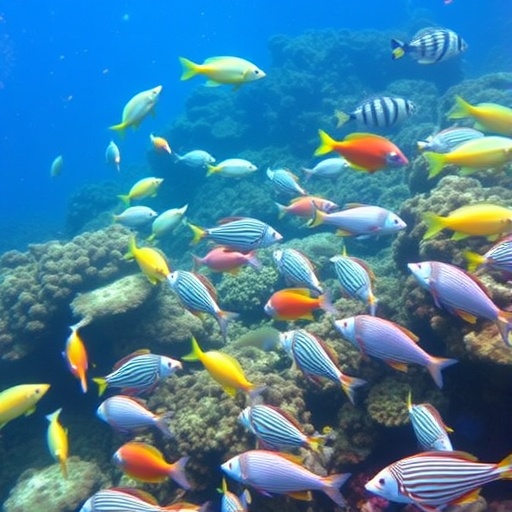In the vibrant underwater landscapes of Veracruz, Mexico, a groundbreaking study has unveiled the fascinating dynamics of cryptobenthic reef fishes, a largely overlooked group. This meticulous research delves into the intricate community structure and their microhabitat associations, revealing the ecological significance of these small yet vital fish species in maintaining reef health and resilience. Cryptobenthic fishes, often hiding in crevices and rocky outcrops, play an essential role in the functioning of coral reef ecosystems, contributing to various ecological processes that sustain marine biodiversity.
The study, conducted by a team of researchers led by Rivera-Higueras, aims to elucidate the patterns of distribution and diversity among cryptobenthic fishes in the region. Utilizing advanced survey techniques, the researchers meticulously cataloged the various species inhabiting different microhabitats within the coral reefs. Their findings highlight the importance of structural complexity in maximizing biodiversity, as these fishes rely on intricate environments that provide both shelter and foraging opportunities.
One striking aspect of the research is the emphasis on how specific microhabitats—such as crevices, overhangs, and even biogenic structures—shape the assemblages of these fishes. The investigation shed light on the preferences of different species, revealing that certain fishes exhibit strong associations with particular microhabitats, which ultimately influences their survival and reproductive success. This nuanced understanding allows for better insights into the ecological roles that cryptobenthic fishes play within the broader reef ecosystem.
The community dynamics of cryptobenthic fishes proved to be exceptionally diverse. The researchers documented varying degrees of abundance and species richness across different habitats, indicating a complex interplay of ecological factors influencing these populations. The findings also underscore the potential impacts of environmental changes and anthropogenic activities, such as coastal development and pollution, which may threaten the delicate balance of these communities.
Another essential element of the study is its implication for conservation efforts. Understanding the cryptobenthic fish communities is critical as scientists and policymakers develop strategies to protect coral reefs. The cryptobenthic fishes often serve as indicators of reef health, and their decline can signal broader ecological issues. Therefore, including these small fishes in conservation assessments could ensure a more comprehensive approach to coral reef management.
The research methodology employed by Rivera-Higueras and colleagues was robust and innovative, employing systematic surveys coupled with environmental data collection. By assessing not only the fish diversity but also the physical characteristics of the microhabitats, the team was able to draw correlations between fish communities and habitat features. Their work exemplifies the importance of interdisciplinary approaches to marine research, blending ecology with environmental science to uncover essential relationships within ecosystems.
In addition to documenting the diversity and abundance of cryptobenthic fishes, the study also identifies key threats to their habitats. Climate change, ocean acidification, and overfishing are pressing issues that could alter community structures and disrupt the delicate balance of reef ecosystems. By highlighting these threats, the research serves as a critical reminder of the urgent need for proactive measures to protect not only the fishes but the entire marine biodiversity that relies on healthy coral reefs.
Following their comprehensive analysis, the researchers provide insights into future directions for study. They recommend the ongoing monitoring of cryptobenthic fish populations, coupled with habitat assessments to track changes over time. This approach will be vital in understanding how these communities respond to both natural and anthropogenic disturbances, shaping future conservation strategies.
The study also calls attention to gaps in existing research regarding cryptobenthic fishes globally. Emphasizing the necessity for regional studies, the authors advocate for broader investigations across different geographical locations to gain a holistic understanding of these fishes and their ecological roles worldwide. This initiative could uncover patterns and trends that inform global conservation policies and local management practices.
Moreover, the findings offer intriguing possibilities for further research into the behavioral ecology of cryptobenthic fish species. Understanding their feeding habits, social interactions, and reproductive strategies could yield valuable insights that extend beyond immediate conservation efforts and contribute to the fundamental biological knowledge of marine species.
In conclusion, Rivera-Higueras et al.’s study stands as a significant contribution to marine science, emphasizing the intricate tapestry of life found within coral reefs. Their work not only enhances our understanding of cryptobenthic fish communities but also serves as a clarion call for the urgent need to acknowledge and protect these vital components of marine ecosystems. As the world grapples with environmental changes, the findings from this research could play a pivotal role in shaping effective conservation strategies that ensure the longevity and resilience of coral reefs and their inhabitants.
Cryptobenthic reef fishes are indeed more than mere inhabitants of the ocean floor; they are essential players in the intricate web of marine life. As researchers continue to uncover the mysteries of these remarkable creatures, their compelling stories will hopefully inspire a deeper appreciation for the wonders of our oceans and the critical need for stewardship and safeguarding marine environments for generations to come.
Subject of Research: Cryptobenthic reef fishes and their microhabitat associations in Veracruz, Mexico.
Article Title: Community structure and microhabitat associations of cryptobenthic reef fishes in Veracruz, Mexico.
Article References:
Rivera-Higueras, M., Hemingson, C.R., Pouchoulen Alemán, A.d. et al. Community structure and microhabitat associations of cryptobenthic reef fishes in Veracruz, Mexico.
Coral Reefs (2025). https://doi.org/10.1007/s00338-025-02763-1
Image Credits: AI Generated
DOI:
Keywords: Coral reefs, Cryptobenthic fishes, Biodiversity, Microhabitat associations, Marine conservation.




